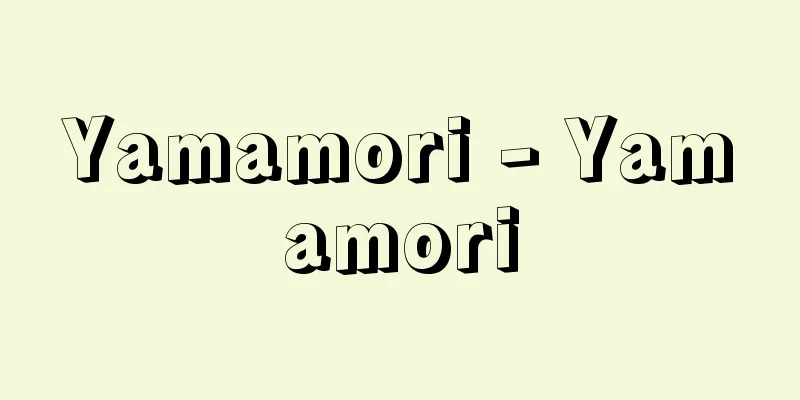Old tales - old stories

|
It is a type of folk tale or oral literature, and together with legends and gossip, it is a representative form of folk literature. It is treated as a synonym for the English term folk tale, the French term conte populaire, the German term Märchen or Erzählung, and the Chinese term folklore. In Japan, the term folk tale was originally an academic term, and the names for folk tales themselves are varied, including "zatto mukashi," "tonto mugashi," "mukashi," "mukashiko," "mugashigadari," "mungatari," "mungate," and "mukashimon." [Keigo Seki] Fairy tale conceptFolk tales have their own unique form of tradition. They begin with opening phrases such as "Once upon a time," "Once upon a time atage na," "Once upon a time atage zu mo na," or "Once upon a time atage kejon," and have specific closing phrases such as "Dottoharai," "Donpe kara konekedo," "Kore ichigo sakke," and "Tonpinpararin nopu." What makes folk tales significantly different from legends and everyday stories is their structure, in which the beginning and end of the story are announced by corresponding opening and closing phrases. The study of folk tales was started by the Brothers Grimm. In 1812, Grimm collected fairy tales that had been passed down among the common people and provided a definition for scientific research. In this context, fairy tales refer to stories told in contrast to Kunstmärchen (written stories). Märchen is originally a diminutive of Märe, which means news or report, and was used in the Middle Ages to mean telling a story. According to Grimm, fairy tales are poetic and legends are historical. Fairy tales are completely blossomed and complete in themselves, while legends are colorless and have the peculiarity of being attached to some known thing, something conscious, a place, or a name confirmed by history. This word shows the starting point of the definition of the concept of fairy tales. Johannes Bolte (1858-1937), an interpreter of the Grimm Brothers' Fairy Tales, also contrasted fairy tales with legends, stating in 1920: [1] Legends heighten the demand for reality and demand faith from the listener. In contrast, fairy tales, which are intended for entertainment, do not focus on secular events. [2] Legends are tied to historical events and people, or to certain surrounding objects, mountains, seas, trees, and buildings. In contrast, fairy tales are not tied to time or space, and they largely abandon the names of objects. [3] Fairy tales begin with "Once upon a time," and end with words that signify the end of the fairy tale itself, the happiness of the protagonist, and the punishment of the villain. In addition, there are rules of narrative, such as a certain number of repetitions, the number three, three stages of development, and the climax of events. Bolte's definition of the concept and scope of fairy tales, based on the criteria of [1] credibility, [2] dependency and fixity, and [3] the presence or absence of form (style), made a great contribution to subsequent studies of fairy tales. His influence can also be seen in Kunio Yanagita, a pioneer in folk tale research in Japan. The compilation of the type catalogue by Aarne in 1910 marked a major milestone in folktale research. Aarne classified folktales into three groups: animal folktales, serious folktales, and jokes, with the aim of conducting comparative research on folktales. In 1928, Stith Thompson translated and supplemented this type catalogue, and later supplemented it further to compile an index of motifs in folk literature, laying the foundation for comparative research. Thomson called Aarne's broad definition of fairy tales folk tales, updated the number of types from 585 to 3,345, and organized and classified them by type number. The motif index contains approximately 40,000 items, which are numbered with letters and numbers. Today, this AT (Aarne-Thompson) number is considered a basic guide for comparing folktales, finding their distribution, and checking their existence. [Keigo Seki] Characteristics of fairy talesIn recent years, the collection of folk tales has progressed in Japan, and the traditional characteristics of folk tales are gradually becoming clearer. Let us take a look at some of them below. (1) In folk tales, there are certain words that are said before the story is told. These words can be called introductory words or oaths. In the Osumi Peninsula of Kagoshima Prefecture, there is a saying, "If it is something from long ago, even if you don't know if it happened or not, please listen as if it did." In the Mogami region of Yamagata Prefecture, there is a saying, "Once upon a time, even if you don't know if it happened or not, you must listen as if it did." Both of these words contain a sense of admonition when attending a folk tale-telling session. These have a unique rhythm that is also shared by the impression of divine storytelling. (2) Folk tales have a specific order in which they are told, and a corresponding procedure. There is a folk tale to be told first, and this forms the setting for storytelling. Folk tales with such special functions, such as "Kappa Hi Yaro," are performed under the name of the Sanbaso. The purpose of this is to create the atmosphere of the folk tale and to liven up the storytelling scene, and a special sound of storytelling language is required. (3) When a folk tale is told, the listener is expected to respond with aiuchi. The words used to respond vary significantly depending on the region. In the Shonai region of Yamagata Prefecture, the response is "Odeyare, odeyare," and in the inland area of Yamagata Prefecture, the response is "Otto." In Sado, the response is "Saasu" and "Saaso," in the Tochio area of Nagaoka City, Niigata Prefecture, the response is "Saansuke," and in Tokunoshima Island in Amami, the response is "Haihai." All of these can be said to be special, non-everyday words. (4) Folk tales have words for the listener that are specific to the storytelling scene. These are words to urge the narrator to continue and words of appreciation for finishing the story. The narrator is urged to continue the story by using phrases such as "Kododeya, kododeya" and "Moshitozu, moshitozu" to extend the story and make the storytelling space a more fulfilling linguistic space. On the other hand, when the story is coming to an end and is successfully concluded, the listener may offer words of thanks to the narrator, such as "Thank you for your hard work. It was interesting," or "Thank you very much." (5) Traditionally, there are strict restrictions and taboos attached to the telling of old tales. One particular taboo found throughout Japan is the strong prohibition of "hiru-mukashi," or "daytime old tales." In other words, the taboo of not telling old tales carelessly during the daytime, which is an everyday occurrence. This makes clear that old tales were traditionally told at night, and that there is a sacred nighttime storytelling among the common people. If anyone violated the sanctity of these night storytellings, they would be warned of unsettling or ominous events occurring around them, such as "rats will urinate," "the princess on the ceiling will urinate on you," "your trousseau will burn," or "if you board a boat you will be shipwrecked," and they would even be threatened with punishment. Furthermore, while folk tales choose specific times, they also contain straightforward phrases that correspond to the season or the place where they are told. We know that folk tales were told on sacred days such as New Year's and seasonal festivals, or in places where people stay overnight for religious services, such as "The fool after the seasonal festival," "The fool after the kotatsu has been taken away," "Folk tales are told on the evening of Koushin," and "New Year's storytelling moistens the seven mountains and seven valleys." Anyone who violated these rules could be expelled from the community as a disruptor of the order of the community, and could even be "chased away from the seven mountains and seven valleys." This clearly shows that folk tales were essential on specific special days that the community maintained as an agricultural lifestyle. Folktales maintain this solemn form of storytelling even when the storytelling is concluded. For example, in some regions, people avoid long-term storytelling, such as "Hundred Tales are accompanied by monsters" or "When you tell a hundred tales, the cat by the hearth will turn into a ghost." In the storytelling space, there are taboos from the beginning to the end of the storytelling, and punishments for violating them. At the same time, warnings to prevent the storytelling space from collapsing are also passed down. This gives a strong impression that folktales could be a non-daily linguistic activity. (6) In folktales, there are "narrators" and "storytelling grandfathers" who meet the conditions for storytelling and who carry on the storytelling. They are so-called storytellers. In various parts of Japan, there are storytellers who carry on many stories, and they are called elders and respected by the people. Storytellers come from important families or lineages within the community. The narrators were people with extremely good memories, well acquainted with the past of their community, and especially rich in folklore related to rituals and agriculture. Among the narrators who could tell a hundred stories, there were even grandmothers who never needed to read or write in their lives. Folktales are often told around the hearth. They are told in front of the fire, either in front of the master's seat, called yokoza or kamiza, or with their backs to the water room or storeroom, facing the kakaza, the housewife's seat facing the fire, the kyakuza, the guest's seat, and the shimoza, the seat of those who work in the house and young people. Listeners listen to the folktales by sitting at the edge of the kyakuza or shimoza, or in some regions while lying down with their headgear completely covered. In the storytelling setting, even the figure and shape of the storyteller should not be overlooked. (7) Folktales are also told by groups of the same age and sex in work huts, wood huts, fishing huts, spinning huts, moon huts, birth huts, etc., apart from the community's telling of folktales following traditional forms. There are also cases where lacquer craftsmen, barrel makers, blacksmiths, millstone and saw sharpeners, woodworkers, basket sellers, fish sellers, medicine sellers, entertainers, and religious figures who frequented the villages brought stories from distant places and were accepted as established folk tales. Among these people, there were some who stayed in the villages for a certain period of time and interacted with the villagers, telling them strange happenings and stories from the world and passing them by. In some cases, people well versed in the arts gather for festivals. There are also cases where travelers are stopped off when bridges are washed away by rising rivers, leaving behind old stories, and when people take refuge in temples or shrines during epidemics. Such examples are not limited to Japan, but are found all over the world. [Keigo Seki] Classification of folk talesThe classification of Japanese folktales is deeply connected to trends in folktale research around the world. In 1934 (Showa 9), Kunio Yanagita wrote "On the Classification of Folktales" (Travels and Legends), which was the pioneer of folktale classification research in Japan. However, Sasaki Kizen of Tono, who had attempted to classify tales into five types prior to Yanagita, had not yet established a solid conceptual framework and could not be used as an objective standard. In 1948 (Showa 23), Yanagita published "A Vocabulary of Japanese Folktales," systematizing his unique views. This marked the first step in the classification of Japanese folktales. Yanagita roughly classified Japanese folk tales into two categories: (1) complete folk tales, and (2) derived folk tales, and organized them as follows. The gist of these is as follows: (1) Complete folk tales Birth and miracles - Momotaro, Chikarataro, Urikohime, etc. Mysterious growth - The Snake Son, The Snail Millionaire, etc. Happy marriages - Netaro the Neighbor, The Cow's Wedding, etc. Tales of stepchildren - Nukabuku Komebuku, Benizara Kakezara, etc. Superiority and inferiority of siblings - Stories about brothers, Younger brother's success, etc. Discovery of treasure - Goro's missing bowl, The power of treasure, etc. Overcoming misfortunes - The story of the demons, The wife who didn't eat, etc. Help from animals - The hearing ears, The golden fan, The silver fan, The tea kettle of fortune, etc. The power of words - the dialogue with the monster, The Carpenter and Oniroku, etc. The power of wisdom - defeating the fox, Ubasute Mountain, etc. (2) Derived folk tales Tales of fate - the singing skeleton, tales determining one's fortunes, etc. Bakemonogatari - the little kobakama, defeating the monster, etc. Funny stories - big stories, poor imitation, foolish village tales, etc. Tales of birds, animals and plants - the filial piety of the sparrow, the cuckoo and her siblings, animal races, fishing by the tail, Kachikachi Mountain, etc. Others (those somewhere between folk tales and legends) - Minister Yuriwaka, the gift of a woman in childbirth, the human sacrifice of a long pole, etc. From the above, Yanagita's perfect folktales are almost identical to full-fledged folktales, and can be considered to be intended as stories about a person's life. In all cases, the protagonist of a perfect folktale has an abnormal and mysterious birth and growth as a small child. That is, the protagonist is born as an extremely small baby from a small, hollow container, grows abnormally, encounters several hardships, and eventually marries happily. This is considered the completion of a person's life, and is considered a perfect folktale. All others are considered to be derivatives of these. On the other hand, Seki Keigo has classified and organized folktales from an international perspective. This classification standard was presented in the 1959 "Collection of Japanese Folktales" and the 1980 "Comprehensive Collection of Japanese Folktales," and was intended for comparative research. Based on the aforementioned Arne-Thomson classification, Seki organized Japanese folktale materials so that they could be searched against European folktale materials. In other words, he classified them as follows, and assigned AT numbers to correspond to Western folktales. (1) Animal folktales Animal conflicts -- fish thief, fishing by tail, etc. Animal distribution -- raccoon dog, rabbit, river otter, fox, raccoon dog, rabbit, etc. Animal races [1] -- snails and foxes, the origin of the 12 Chinese zodiac signs, the running of fleas and lice, etc. Animal Races (2) - The monkey and crab compete for rice cakes, the monkey and toad steal rice cakes, etc. The monkey and crab battle - A monkey's night thief, A monkey and a crab meet in the rice field, etc. Kachikachi Mountain - Kachikachi Mountain, etc. The leak in the old house - The leak in the old house. Animal society - A rice field where mice and weasels meet, A monkey's raw liver, etc. The previous life of the little bird - The cuckoo and its brothers, A filial piety of a sparrow, etc. Animal origins - The dog's leg, The wild goose and the turtle, etc. (2) Authentic folk tales Marriage and a bride of a different species - A snake's bride and groom, etc. Marriage and a wife of a different species - A snake's wife, a frog's wife, etc. Marriage and a bride with a difficult problem - A wife who looks like a picture, etc. Birth - A snail's son, a frog's son, etc. Fate and attaining wealth - the charcoal burner millionaire, the dialogue with the birth god, etc. Tales of cursed treasure - the hearing ear, The dog, the cat and the ring, etc. Tales of brothers - the three brothers, The pear pickers of Nara, etc. The old man next door - Jizo Pure Land, Mouse Pure Land, etc. The old man's guest - the monkey millionaire, The treasure handkerchief, etc. Tales of stepchildren - rice fortune, millet fortune, Saratanyama, etc. A foreign land - the Dragon Palace boy, Urashima Taro, etc. Animals repaying their kindness - the wolf's kindness, The cat's parishioner, etc. Tales of escape - The three amulets, etc. Foolish animals - the blacksmith's wife, The cat and the pumpkin, etc. Man and fox - Peeking at the butt, Yamabushi fox, etc. (3) Funny Stories: Stories of fools - the foolish village, the foolish groom, the foolish bride, the foolish man, etc. Exaggerated tales - the story of Mount Hachikoku, Gengoro's ascent to the sky, etc. Tales of cleverness - the story of the Nio and the Gao, etc. Tales of cunning people - the story of the crow and the pheasant, etc. Formal tales - the fate of the wanderer, etc. The above is the classification of the two, but Yanagita sees the old form or style of folktales in the complete folktales, and the secondary physical passage of time in the derivative folktales. In contrast, Seki positions the three folktale groups as coexisting. Moreover, he does not recognize any temporal differences or superiority or inferiority between the three folktales. [Keigo Seki] "A Vocabulary of Japanese Folktales (1948), supervised by Yanagita Kunio and edited and published by the Japan Broadcasting Corporation" ▽ "Complete Collection of Japanese Folktales, 12 volumes, edited by Seki Keigo (1978-80, Kadokawa Shoten)" ▽ "Collected Works of Seki Keigo, Volume 6: An Introduction to Comparative Research (1982, Dohosha Publishing)" ▽ "Research on Folktale Transmission, by Nomura Junichi (1984, Dohosha Publishing)" ▽ "World Folktales 25: Commentary, by Ozawa Toshio (1978, Gyosei)" Source: Shogakukan Encyclopedia Nipponica About Encyclopedia Nipponica Information | Legend |
|
民間説話あるいは口承文芸の一類で、伝説・世間話とともに、民間に行われる代表的な常民の文芸をいう。英語folk tale、フランス語conte populaire、ドイツ語Märchen、Erzählung、中国語の民間故事、などの同義語として扱われる。わが国の場合、昔話の語は、本来は学術用語で、民間にあっての昔話そのものの呼称は、「ざっとむかし」「とんとむがし」「むかし」「むかしこ」「むがしがだり」「むんがたり」「むんがて」「むかしもん」など多様である。 [関 敬吾] 昔話の概念昔話は固有の伝承の形式をもつ。冒頭句の、「むかしむかし」「むかしあったげな」「むかしあったずもな」「むかしあったけじょん」などで語り始め、「どっとはらい」「どんぺからこねけど」「これでいっちごさっけ」「とんぴんぱらりんのぷ」などの、特定の結句も有する。昔話が伝説・世間話と著しく異なるところは、冒頭と結びの相対応する語句によって、その物語の開始と終結を告げる、この結構による。 昔話の研究はグリム兄弟により始められた。グリムは、1812年に、庶民の間に伝承されたメルヒェンを収集し、科学研究のために定義を与えた。ここにいうところのメルヒェンは、創作童話Kunstmärchen(書かれた話)に対して語る物語をさす。メルヒェンは、本来はメーレMäreの指小詞である。メーレはニュース、報告を意味し、中世では物語を語るという意味で使用されている。 グリムによれば、メルヒェンは詩的であり、伝説Sageは歴史的である。昔話はまったくそれ自身で開花し、完成しているが、伝説は色彩に乏しく、なんらかの既知のもの、意識されたもの、場所あるいは歴史によって確実にされた名前に密着するという特殊性をもつ、とされる。このことばは、昔話の概念規定の出発点を示している。 また、グリム昔話の解説者であるボルテJohannes Bolte(1858―1937)も、昔話と伝説を対比し、1920年に以下のように述べた。 〔1〕伝説は現実性を与えようとする要求を高め、聞き手の信仰を求める。これに対し、娯楽を意図する昔話は、世俗的な事件にこだわらない。〔2〕伝説は、歴史的事件・人物、あるいは周辺の一定の事物・山・海・樹木・建物に絡みつく。これに反し、昔話は、時間や空間に結び付かず、事物の名前の大部分を放棄する。〔3〕昔話の語り方は、「むかしむかしある所に」で始まり、最後は、昔話そのものの終了、主人公の幸福、悪人の懲罰を意味することばで終わる。さらに一定の繰り返し、三の数および三段階の展開、事件の高揚などの、叙事の法則がある。ボルテのこの〔1〕信憑(しんぴょう)性、〔2〕依存性・定着性、〔3〕形式(様式)の有無を基準とした昔話の概念規定、範囲の基準は、以後の昔話研究に多大の貢献をなした。わが国の昔話研究の先駆者柳田国男(やなぎたくにお)にも、その影響は認められる。 なお、1910年にアンティ・アールネが行ったタイプ目録編纂(へんさん)は、昔話研究に大きな足跡を記した。アールネは、昔話の比較研究を目的に、動物昔話、本格昔話、笑話の三群に分類した。ついで、1928年、スティス・トムソンはこのタイプ目録を翻訳、補充し、後年さらに補充して、民間文芸のモチーフ索引を編し、比較研究の基盤をつくった。トムソンは、アールネの広義のメルヒェンをfolk taleとよび、そのタイプ数を585から3345種に更新し、タイプ番号によって整理・分類した。モチーフ索引は約4万に及びアルファベットと数字の番号で示される。このAT(Aarne-Thompson)番号は、今日、昔話の比較、分布、その存在の照合などにとって、基本的な手引ともされる。 [関 敬吾] 昔話の特性近年、わが国では、昔話資料の採集が進み、昔話の伝承的特性がしだいに明らかになりつつある。以下に取り上げてみよう。(1)昔話には、物語を語るに際し、それに先駆けていう特定のことばがある。いわゆる前置きのことば、あるいは誓詞ともいいうべきことばである。鹿児島県大隅半島では、「むかしのことなれば、あったかなかった知らねども、なかったこともあったことにして聴いてくれ」という。山形県最上(もがみ)地方では、「むかしむかし、あったかなかったか知らねども、あったことにして聞かずばなるまい」ということばが残されている。いずれも、昔話の場に臨むに際しての、戒めの意が込められている。これらには、神語りの印象にも通う独自の韻律が内在する。(2)昔話には、語りの順序があり、相応の手続がある。最初に語る昔話があって、語りの場を形成する。こうした特別の機能を有する昔話には、「河童(かっぱ)火やろう」などが話の三番叟(さんばそう)の名称で行われる。ここには、昔話の雰囲気をつくりだし、語りの場を盛り上げる目的があり、特殊な語りことばの響きが求められる。(3)昔話が語り出されると、聴き手に対して相槌(あいづち)が要求される。相槌のことばは土地により著しく異なる。山形県庄内(しょうない)地方では「おでやれ、おでやれ」、山形県内陸部では「おっとう」と応じる。佐渡では「さーす」「さーそ」、新潟県長岡(ながおか)市栃尾(とちお)地区では「さあんすけ」、奄美(あまみ)の徳之島では「はいはい」と応じている。これらはみな特殊な非日常のことばであるともいえる。(4)昔話には、語りの場に特定される聴き手のことばがある。語り手に対して語りを催促することばと、語り終わったことに対するねぎらいのことばである。語りを促すのは、「こどでや、こどどや」「もしとず、もしとず」など、語りを延長させ、語りの場をより充実した言語空間にするべく、催促する仕儀がみられる。一方、語りが終結に向かい、無事に収束した場合には、聴き手の「ご苦労でやした。おもしろうござった」「かたじけのうやした」などの、語り手への慰労の礼詞がある。(5)昔話には、元来、昔話を語ること自体に、厳しい制約や禁忌事項が付随する。とくにわが国全域にみられるものに、「昼むかし」の強い禁止がある。すなわち、不用意に日常的な昼間に昔話を語るな、という禁忌である。これは、昔話が、伝統的に、夜に語られるものであり、庶民の間の神聖な夜(よ)語りの存在を明瞭(めいりょう)にしている。この夜語りの神聖さを侵犯した場合には、「ねずみが小便する」「天井(てんじょう)のお姫さんに小便かけられる」「嫁入り道具が燃える」「舟に乗ると難破する」など、身辺に不穏・不吉な事態の発生を予告され、制裁さえにおわされる。 また、昔話には、特定の時を選ぶと同時に、その季節や語りの場の直截(ちょくせつ)な言い継ぎのことばがある。「節供すぎての馬鹿むがし」「炬燵(こたつ)とれての馬鹿むがし」「昔話は庚申(こうしん)の宵(よい)」「正月語りは七嶺七沢(ななみねななさわ)潤う」など、昔話が聖なる日である正月・節供や、神ごとの夜籠(よごも)り講などの場を選んで行われたことが知られる。これらを侵した者は、共同体の秩序を乱した者として、共同体からの放逐、「七嶺七沢追われる」事態もありえた。それは、農耕生活者として、共同体が維持してきたハレの日の特定される日に、昔話が不可欠なものであったことを如実に示す。 昔話は、このような語りの厳粛な姿を、語りの収束にあたっても保持している。たとえば、「百物語は化け物が出る」「百物語すると囲炉裏端(いろりばた)の猫が化ける」など、長時間にわたる語りを忌避する地方もある。昔話の場には、語りの冒頭から終結まで、禁忌やそれを侵犯した際の制裁がある。語りの場には、その崩壊を防ぐための戒めも、同時に伝え残しているのである。そこには、昔話が非日常の言語活動でありえたことの印象が強くうかがえる。(6)昔話には、語りの条件を具備し、語りを継承する「語り婆(ばば)さ・語り爺(じじ)さ」がいる。いわゆる語り手である。日本の各地には、語りを数多く継承する語り手が存在し、古老とよばれ、人々から尊敬された。語り手は、共同体のなかの、重きを置かれる家筋や家系の出自であった。語り手は、きわめて記憶力がよく、共同体の過去に通じ、とりわけ祭祀(さいし)や農事にかかわる伝承に富む人々であった。百話クラスの語り手のなかには、生涯にわたり文字を必要としなかった媼(おうな)も存在する。 昔話は、多く囲炉裏端で行われる。囲炉裏火の前、ヨコザ・カミザとよばれる主人の座居する正面、あるいは水屋や納戸(なんど)を背にして、囲炉裏火に対する主婦の座、カカザから、客の座とされるキャクザ、家で働く人々や若い者たちの座るシモザに向けて行われる。聴き手は、キャクザやシモザに端座し、あるいは地方によっては被(かぶ)り物で身体を覆い尽くした寝姿で、昔話を享受した。語りの場では、語り手の座居する姿・形ですら見逃してはならない。(7)昔話はまた、伝承的な形式を踏襲する共同体の語りとは別に、作業小屋、木小屋、漁小屋、糸繰(いとく)り小屋、月事(つき)小屋、産(さん)小屋などで、同年齢集団・同性集団により行われた。また、村落に出入りした漆かき、桶(おけ)屋、鍛冶屋(かじや)、石臼(いしうす)・鋸(のこぎり)の目立(めたて)、木地(きじ)屋、籠(かご)売り、魚売り、薬売り、芸人、宗教者などが遠隔地から話柄(わへい)を運び、定着した昔話として受容された例もある。こうした人々のなかには、一定期間村落に停留して村人と交流し、世間の異事・異聞を語り、それを身過ぎ世過ぎとした人々もある。 芸能に通じた者たちが祭礼に集まってくる場合もある。河川の増水で橋が流出し、旅の人々が足をとめた際に、昔話を残したという例や、疫病が大流行したおりに、避難してこもった寺院や堂社で昔話を行ったという例もあった。こうした例は、わが国に限らず、世界各国でも行われた。 [関 敬吾] 昔話の分類わが国の昔話の分類は、世界の昔話研究動向と深くかかわる。柳田国男は、1934年(昭和9)「昔話の分類に就いて」(『旅と伝説』)を著し、わが国昔話分類研究の嚆矢(こうし)となった。なお、柳田に先んじて試みられた遠野(とおの)の佐々木喜善(きぜん)の5種類の説話群の分類は、いまだ概念規定が確固としたものではなく、客観的基準とはなしえなかった。1948年(昭和23)柳田は『日本昔話名彙(めいい)』を上梓(じょうし)し、その独自の見解を体系づけた。これによって、わが国の昔話分類研究は第一歩を踏み出した。 柳田は、日本の昔話を(1)完形昔話、(2)派生昔話に大きく分類し、整理した。その大要は以下である。(1)完形昔話 誕生と奇瑞(きずい)――桃太郎・力(ちから)太郎・瓜子姫(うりこひめ)など。不思議な成長――蛇息子・田螺(たにし)長者など。幸福なる婚姻――隣の寝太郎・牛の嫁入など。継子(ままこ)譚――糠福米福(ぬかぶくこめぶく)・紅皿欠皿(べにざらかけざら)など。兄弟の優劣――兄弟話・弟出世など。財宝発見――五郎の欠椀(かけわん)・宝物の力など。厄難克服――鬼むかし・食わず女房など。動物の援助――聴耳(ききみみ)・金の扇銀の扇・分福茶釜(ぶんぶくちゃがま)など。ことばの力――化物(ばけもの)問答・大工と鬼六(おにろく)など。知恵のはたらき――狐(きつね)退治・姥棄(うばすて)山など。(2)派生昔話 因縁話――歌い骸骨(がいこつ)・運定め話など。化物語――ちいさい小袴(こばかま)・化物退治など。笑話――大話・真似(まね)そこない・愚かな村話など。鳥獣草木譚(たん)――雀(すずめ)孝行・時鳥(ほととぎす)と兄弟・動物競争・尻尾(しっぽ)の釣・かちかち山など。その他(昔話と伝説の中間をゆくもの)――百合若(ゆりわか)大臣・産女(うぶめ)の礼物・長柄(ながら)の人柱など。 以上から、柳田の完形昔話はほぼ本格昔話と一致し、人の一生の物語を意図するものと考えられる。完形昔話の主人公は、いずれの場合も、小(ちい)さ子として異常かつ不思議な出生と成長を遂げる。すなわち、小さなうつろな入れ物の中から、きわめて小さな姿の幼子(おさなご)として誕生し、異常な成長をみせ、いくつかの厄難に遭遇し、やがて幸福な婚姻に至る。これを人の一生の完結とみなし、完形昔話とした。そのほかは、すべてこれらの派生であるとしたのである。 一方、関敬吾は、国際的な視野から、昔話の分類・整理を行った。それは、1959年の『日本昔話集成』、1980年の『日本昔話大成』に示され、比較研究を目的にした分類基準である。関は、前述のアールネ‐トムソンの分類に基づいて、日本の昔話資料の整備を行い、ヨーロッパの昔話資料に照合検索をなしうるようにした。すなわち以下のように分類し、AT番号を付して西欧と照応させた。(1)動物昔話 動物葛藤(かっとう)――魚泥棒・尻尾の釣など。動物分配――狸(たぬき)と兎(うさぎ)と川獺(かわうそ)・狐と狸と兎など。動物競争〔1〕――田螺と狐・十二支の由来・蚤(のみ)と虱(しらみ)の駆け足など。動物競争〔2〕――猿蟹餅(さるかにもち)競争・猿と蟇(がま)の餅泥棒など。猿蟹合戦――猿の夜盗・猿と蟹の寄合田など。かちかち山――かちかち山など。古屋の漏(もり)――古屋の漏。動物社会――鼠(ねずみ)と鼬(いたち)の寄合田・猿の生肝(いきぎも)など。小鳥前生――時鳥と兄弟・雀孝行など。動物由来――犬の脚(あし)・雁(がん)と亀(かめ)など。(2)本格昔話 婚姻・異類聟(むこ)――蛇聟入など。婚姻・異類女房――蛇女房・蛙(かえる)女房など。婚姻・難題聟――絵姿女房など。誕生――田螺息子・蛙息子など。運命と致富――炭焼長者・産神(うぶがみ)問答など。呪宝(じゅほう)譚――聴耳・犬と猫と指環(ゆびわ)など。兄弟譚――3人兄弟・奈良梨採(なしと)りなど。隣の爺――地蔵浄土・鼠浄土など。大歳(おおどし)の客――猿の長者・宝手拭(てぬぐい)など。継子譚――米福粟(あわ)福・皿々山など。異郷――竜宮童子・浦島太郎など。動物報恩――狼(おおかみ)報恩・猫檀家(だんか)など。逃竄(とうざん)譚――三枚の護符など。愚かな動物――鍛冶屋の婆・猫と南瓜(かぼちゃ)など。人と狐――尻(しり)のぞき・山伏狐など。(3)笑話 愚人譚――愚かな村・愚か聟・愚か嫁・愚かな男など。誇張譚――八石山(はちこくやま)・源五郎の天のぼりなど。巧智(こうち)譚――仁王(におう)と賀王(がおう)など。狡猾(こうかつ)者譚――烏(からす)と雉子(きじ)など。形式譚――廻(まわ)りもちの運命など。 二者の分類は以上であるが、柳田は、完形昔話に昔話の古型もしくは古態をみいだし、派生昔話に二次的な物理的時間の経過をみている。これに対し、関は、三つの昔話群を並存するものとして位置づけた。しかも、三つの昔話間には、いっさいの時間的差異・優劣は認めていない。 [関 敬吾] 『柳田国男監修、日本放送協会編・刊『日本昔話名彙』(1948)』▽『関敬吾編著『日本昔話大成』全12巻(1978~80・角川書店)』▽『『関敬吾著作集 6 比較研究序説』(1982・同朋舎出版)』▽『野村純一著『昔話伝承の研究』(1984・同朋舎出版)』▽『小沢俊夫著『世界の民話25 解説編』(1978・ぎょうせい)』 出典 小学館 日本大百科全書(ニッポニカ)日本大百科全書(ニッポニカ)について 情報 | 凡例 |
<<: Ancient dragonfly - Ancient dragonfly
Recommend
Alhambra Vase - Alhambra Vase
…The most typical type of Hispano-Moresque potter...
Support system - Yokusan Taisei
The political system during World War II centered ...
Fruitlands
...The Transcendentalist social reform movement c...
duḥkha (English spelling) duhkha
…The term duḥkha (suffering) is first used in the...
Procellariidae
...A general term for birds in the Procellariidae...
Walther Hermann Nernst
German physical chemist and discoverer of the thi...
Vaclav III (English spelling)
...The Czechs became a major power within the emp...
Sasaya Pass - Sasaya Pass
A pass on the border between Kawasaki Town, Shiba...
Floating floor - Ukiyuka
...In addition to these general floors, there are...
Shellfish
A general term for mollusks with calcareous shells...
Salisbury Plain
A plain in central Wiltshire, southwest England, U...
Stranger - Outsider
A household or person who is not recognized as a m...
Lamium - Let's dance
A perennial plant of the Lamiaceae family (APG cl...
CLO - Collateral loan obligation
A mechanism for liquidating and securitizing loans...
Kadoma [city] - Kadoma
A city in central Osaka Prefecture. It was incorpo...


![Ohamu (Oonamitake) - Ohamu (English spelling) black-throated diver [England]](/upload/images/67cb17b5f0f56.webp)



![Anglo-Swiss Condensed Milk [company] - Anglo-Swiss Condensed Milk](/upload/images/67cf4c6d4b7f4.webp)


